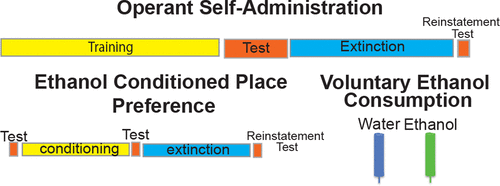当前位置:
X-MOL 学术
›
ACS Chem. Neurosci.
›
论文详情
Our official English website, www.x-mol.net, welcomes your feedback! (Note: you will need to create a separate account there.)
Studying Sex Differences in Animal Models of Addiction: An Emphasis on Alcohol-Related Behaviors
ACS Chemical Neuroscience ( IF 5 ) Pub Date : 2017-12-11 00:00:00 , DOI: 10.1021/acschemneuro.7b00449 Elisa R. Hilderbrand , Amy W. Lasek
ACS Chemical Neuroscience ( IF 5 ) Pub Date : 2017-12-11 00:00:00 , DOI: 10.1021/acschemneuro.7b00449 Elisa R. Hilderbrand , Amy W. Lasek

|
Animal models are essential for understanding the biological factors that contribute to drug and alcohol addiction and discovering new pharmacotherapies to treat these disorders. Alcohol (ethanol) is the most commonly abused drug in the world, and as the prevalence of alcohol use disorder (AUD) increases, so does the need for effective pharmacotherapies. In particular, treatments with high efficacy in the growing number of female AUD sufferers are needed. Female animals remain underrepresented in biomedical research and sex differences in the brain’s response to alcohol are poorly understood. To help bridge the gender gap in addiction research, this Review discusses strategies that researchers can use to examine sex differences in the context of several common animal models of AUD. Self-administration, two-bottle choice, drinking in the dark, and conditioned place preference are discussed, with a focus on the role of estrogen as a mediator of sex differences in alcohol-related behaviors.
中文翻译:

在成瘾动物模型中研究性别差异:对酒精相关行为的重视
动物模型对于理解导致药物和酒精成瘾的生物学因素以及发现治疗这些疾病的新药物疗法至关重要。酒精(乙醇)是世界上最常滥用的药物,并且随着酒精使用障碍(AUD)的患病率增加,对有效药物治疗的需求也在增加。特别地,需要在越来越多的女性AUD患者中具有高疗效的治疗。雌性动物在生物医学研究中的代表性不足,人们对酒精反应的大脑性别差异知之甚少。为了弥合成瘾研究中的性别鸿沟,本评论讨论了研究人员可用来在AUD的几种常见动物模型的背景下检查性别差异的策略。自我管理,两瓶选择,在黑暗中喝酒,
更新日期:2017-12-11
中文翻译:

在成瘾动物模型中研究性别差异:对酒精相关行为的重视
动物模型对于理解导致药物和酒精成瘾的生物学因素以及发现治疗这些疾病的新药物疗法至关重要。酒精(乙醇)是世界上最常滥用的药物,并且随着酒精使用障碍(AUD)的患病率增加,对有效药物治疗的需求也在增加。特别地,需要在越来越多的女性AUD患者中具有高疗效的治疗。雌性动物在生物医学研究中的代表性不足,人们对酒精反应的大脑性别差异知之甚少。为了弥合成瘾研究中的性别鸿沟,本评论讨论了研究人员可用来在AUD的几种常见动物模型的背景下检查性别差异的策略。自我管理,两瓶选择,在黑暗中喝酒,



























 京公网安备 11010802027423号
京公网安备 11010802027423号